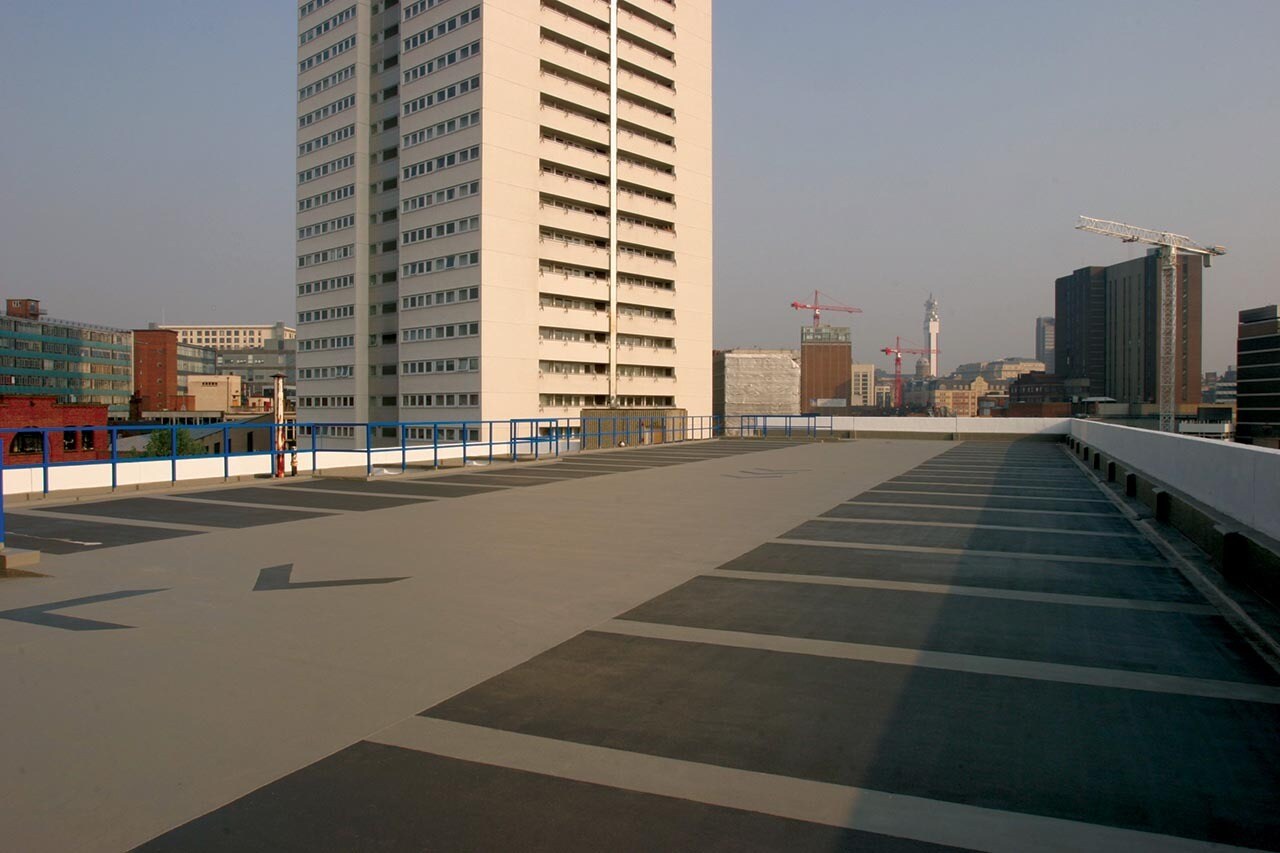Commercial structures face numerous challenges, especially foot and vehicle traffic. Various weather conditions, including precipitation, exposure to UV rays, high winds, and extreme temperature variations, also take their toll. The undesirable consequences include accelerated wear in high-traffic areas, rust of the reinforcing steel, and corrosion.
The solution? A traffic coating system that provides protection against mechanical wear and the elements.
What Is a Traffic Coating?
So, just what is a traffic coating? A traffic coating is a multi-layered system designed to shield a structure from moisture and contaminants. These coatings are primarily applied in layers: a primer, a waterproofing base coat, a layered wear course of aggregates, and a topcoat.
While traffic coating systems often provide protection against water damage, their primary function is to bear pedestrian and vehicular traffic rather than provide dedicated waterproofing.
Types of Traffic Coatings
There are four major types of traffic coatings; each has its optimal use, along with strengths and potential drawbacks.
Polyurethane Systems
Polyurethane systems provide a waterproof traffic coating surface that can fill cracks and withstand reapplication rather than requiring complete reinstallation. Polyurethane has low VOC properties and is well-suited for elevated plaza decks as well as areas subject to high wear, such as parking deck exits and entrances, ramps, and turning areas. However, polyurethane can have low movement capabilities, can be difficult to install, and is sensitive to moisture.
Epoxy Broadcast Systems
Epoxy broadcast systems are inexpensive, durable, and easy to apply, making them well suited for parking garages and ramps. Epoxy broadcast systems also have strong UV resistance and are ideal for interior applications due to their low odor. However, the material has no waterproofing capability and is subject to cracking and corrosion over time.
PMMA Systems
Polymethyl methacrylate (PMMA) systems can be applied in temperatures as low as 23°F and are resistant to atmospheric humidity during application. PMMA systems are also highly durable, making them ideal for parking decks, balconies, and other vehicular and pedestrian traffic-bearing surfaces. However, they are higher-end materials and carry a distinctive odor during application. Nonetheless, having a project open to service within hours, not days, can offset the initial expenditure of PMMA traffic coatings.
Sealers
Sealers are inexpensive and easily applied, have low VOC properties, and do not alter the appearance of the materials they cover. However, sealers cannot fill cracks, have no waterproofing qualities, and require frequent reapplication.
Benefits of Using Traffic Coating
A well-installed and properly maintained traffic coating system can protect a structure by enhancing its ability to withstand heavy foot and vehicle traffic. It can also provide enhanced energy efficiency, resistance to water damage, and aesthetics. Proper selection of materials can help maximize the effectiveness and durability of both the traffic coating solution and the structure itself.
Installation Process and Best Practices
Proper installation is as important as selecting the right traffic coating system materials. Surface preparation, including sealing cracks, patching voids, and ensuring a dust-free surface, is essential to prevent problems, such as debonding or uneven surfaces in a finished installation. Following manufacturer specifications and maintaining consistent thickness and consistency are musts.
Matching materials with intended use—such as PMMA systems for high-traffic areas—is mandatory. Matching existing coatings with new materials is ideal. When that isn't an option, intermediate layers or versatile compounds can reduce the risk of brittleness, discoloration, or other interactions of incompatible materials.
Finally, safety should be more than an afterthought, especially in areas that remain in operation during the installation process. Cautionary signage and barriers around hazardous areas can help reduce the risk of accidents.
Maintenance and Repair of Traffic Coatings
Proper maintenance is essential in ensuring a long service life for traffic coatings. Regular eyeball surface inspections can identify glaring issues, such as cracks or delamination. A thorough inspection can reveal faults in the sealant or joints as well as cracks in stress areas, such as vertical support beams and protrusions, and excessive wear in areas that experience heavy vehicular traffic.
Repairs should be made by patching and replacing sealant and coatings to correct cracks and blisters and prevent potential structural damage.
Choosing the Right Traffic Coating System
The purpose that a traffic coating will serve is a key factor to consider when making a selection. For example, a high-volume parking garage demands an entirely different approach than a private balcony or pedestrian walkway.
A top-quality professional installer has the expertise to make specific recommendations for each aspect of a project. When seeking a reference for a professional installer, look for reputation, quality, and experience rather than automatically opting for the lowest estimate.
Protecting Your Structure with Traffic Coatings
It can be tempting to take shortcuts or employ patchwork solutions as a cost-cutting measure. However, when considered against the disruption of weeks of repair due to wear or weather on unprotected concrete, the return on investment of traffic coatings can be a smart investment.
Due diligence through proper design, selection, application, and maintenance is key to optimal performance and longevity for traffic coating systems. Regular inspections and reviews can catch problems, such as cracks or blisters, early—before they develop into major failures. Likewise, it's imperative to consult with experienced professional installers with a reputation for doing the job right.


